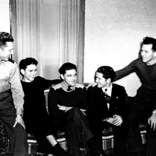

Sullivan Brothers Iowa Veterans Museum, Waterloo, Iowa
Waterloo’s five Sullivan Brothers gained national attention when they enlisted in the Navy after the attack on Pearl Harbor and insisted they be allowed to “stick together” while in the service. After initially refusing, the Navy granted their request. All five brothers were lost when their ship, the USS Juneau, was torpedoed on November 13, 1942, following the Battle of Guadalcanal. This sacrifice remains the largest single loss for a family in American military history.
“As Commander-in-Chief, I want you to know that the entire nation shares your sorrow … I am sure that we all take heart in the knowledge that they fought side by side. As one of your sons wrote, ‘We will make a team together that can’t be beat.’ It is this spirit which in the end must triumph.”
— President Franklin D. Roosevelt to Thomas and Aleta Sullivan, January 13, 1943
The Sullivan Brothers Iowa Veterans Museum honors the service and sacrifice of all Iowa  veterans from the Civil War to present. Step into their stories through traditional exhibits, interactive activities and an electronic Wall of Honor. The Museum consists of over 35 interactive exhibits. Interviews collected via the Voices of Iowa Oral History Project total over 1,500
veterans from the Civil War to present. Step into their stories through traditional exhibits, interactive activities and an electronic Wall of Honor. The Museum consists of over 35 interactive exhibits. Interviews collected via the Voices of Iowa Oral History Project total over 1,500
HOME / SITES & EXHIBITS / SULLIVAN BROTHERS IOWA VETERANS MUSEUM
The Story of the Sullivan Brothers and Their Impact on Navy Policy…
The Sullivans enlisted in the US Navy on January 3, 1942, with the stipulation that they serve together. The Navy had a policy of separating siblings, but this was not strictly enforced. George and Frank had served in the Navy before, but their brothers had not. All five were assigned to the light cruiser USS Juneau. (all links provided by Wickipedia).
Early in the morning of November 13, 1942, during the Naval Battle of Guadalcanal, the Juneau was struck by a Japanese torpedo and forced to withdraw. Later that day, as it was leaving the Solomon Islands’ area for the Allied rear-area base at Espiritu Santo with other surviving US warships from battle, the Juneau was struck again, this time by a torpedo from Japanese submarine I-26. The torpedo likely hit the thinly armored light cruiser at or near the ammunition magazines and the ship exploded and quickly sank.
Captain Gilbert C. Hoover, commanding officer of the light cruiser USS Helena and senior officer present in the battle-damaged US task force, was skeptical that anyone had survived the sinking of the Juneau and believed it would be reckless to look for survivors, thereby exposing his wounded ships to a still-lurking Japanese submarine. Therefore, he ordered his ships to continue on towards Espiritu Santo. Helena signaled a nearby US B-17 bomber on patrol to notify Allied headquarters to send aircraft or ships to search for survivors.
But in fact, approximately 100 of Juneau‘s crew had survived the torpedo attack and the sinking of their ship and were left in the water. The B-17 bomber crew, under orders not to break radio silence, did not pass the message about searching for survivors to their headquarters until they had landed several hours later. The crew’s report of the location of possible survivors was mixed in with other pending paperwork actions and went unnoticed for several days. It was not until days later that headquarters staff realized that a search had never been mounted and belatedly ordered aircraft to begin searching the area. In the meantime, Juneau’s survivors, many of whom were seriously wounded, were exposed to the elements, hunger, thirst, and repeated shark attacks.
Eight days after the sinking, ten survivors were found by a PBY Catalina search aircraft and retrieved from the water. The survivors reported that Frank, Joe and Matt died instantly, Al drowned the next day, and George survived for four or five days,[1] before suffering from delirium as a result of hypernatremia (though some sources describe him being “driven insane with grief” at the loss of his brothers); he went over the side of the raft he occupied. He was never seen or heard from again.
Security required that the Navy not reveal the loss of Juneau or the other ships so as not to provide information to the enemy. Letters from the Sullivan sons stopped arriving at the home and the parents grew worried, which prompted Alleta Sullivan to write to the Bureau of Naval Personnel in January 1943, citing rumors that survivors of the task force claimed that all five brothers were killed in action.[2]
This letter was answered by President Franklin D. Roosevelt on January 13, 1943, who acknowledged that the Sullivans were missing in action, but by then the parents were already informed of their fate, having learned of their deaths on January 12.[2] That morning, the boys’ father, Tom, was preparing for work when three men in uniform – a lieutenant commander, a doctor and a chief petty officer – approached his door. “I have some news for you about your boys,” the naval officer said. “Which one?” asked Tom. “I’m sorry,” the officer replied. “All five.”[3]
The brothers left a sister, Genevieve (1917–1975). Al was survived by his wife Katherine Mary and son Jimmy. Joe left a fiancée named Margaret Jaros, while Matt left behind a fiancée named Beatrice Imperato.[1] The “Fighting Sullivan Brothers” became national heroes. President Roosevelt sent a letter of condolence to their parents. Pope Pius XII sent a silver religious medal and rosary with his message of regret. The Iowa Senate and House adopted a formal resolution of tribute to the Sullivan brothers.
Tom and Alleta Sullivan made speaking appearances at war plants and shipyards on behalf of the war effort.[4] Later, Alleta participated in the launching of a destroyerUSS The Sullivans, named after her sons.[5]
On Saturday, March 17, 2018 the wreckage of the USS Juneau was discovered by Microsoft co-founder Paul Allen off the coast of the Solomon Islands.[6]
- As a direct result of the Sullivans’ deaths (and the deaths of four of the Borgstrom brothers within a few months of each other two years later), the U.S. War Department adopted the Sole Survivor Policy.[7]
- A museum wing has been built in honor of their service in World War II. The museum is located in downtown Waterloo, Iowa, their hometown. It was completed in 2008. The grand opening occurred on November 15, 2008. The $11.5 million, state-of-the-art facility aims to play a role in preserving the history and service of Iowa veterans and serve as a facility for research and genealogy studies.[8]
- The Navy named two destroyers The Sullivans to honor the brothers: The Sullivans (DD-537) and The Sullivans (DDG-68). DD-537 was the first American Navy ship ever named after more than one person. The motto for both ships was/is “We stick together.”[9]
- Al Sullivan’s son served on board the first USS The Sullivans. His grandmother christened the first ship. The second USS The Sullivans was christened by Al’s granddaughter Kelly Ann Sullivan Loughren.[10]
- Thomas and Alleta Sullivan toured the country promoting war bonds and asked that none of their sons died in vain.[11]
- Genevieve, their only sister, served in the WAVES. She was the girlfriend of Bill Ball, whose death at Pearl Harbor prompted her brothers to join the Navy to avenge him.[12]
- The brothers’ story was filmed as the 1944 movie The Sullivans (later renamed The Fighting Sullivans) and inspired, at least in part, the 1998 film Saving Private Ryan.[13] The Sullivans were also briefly mentioned in Saving Private Ryan.
- The brothers’ hometown of Waterloo, Iowa, renamed its convention center in 1988 as “The Five Sullivan Brothers Convention Center”. In June 2017, the city was considering a proposal to sell the center to a developer who would renovate the facility and change its name. The proposal met with some community opposition.[14] The town also named a street and a public park in their honor. The park is the location of their childhood home.[15]
- The Sullivans were not the only brother sailors on board the ship. There were at least thirty sets of brothers, including the four Rogers brothers from New Haven, Connecticut. Before the ill-fated Savo Island operation, two of the Rogers brothers were transferred to other commands. According to those who survived, had the ship returned to port safely, at least two Sullivans would have also transferred.[1]
- The Sullivan Brothers have a Department of Defense Dependents Schools elementary school in Yokosuka, Japan, named in their honor.[16]
- The song “Sullivan” by the alternative rock band Caroline’s Spine tells the story of the Sullivans.[17]
- The Sullivans Association, an organization of veterans who served on both US Navy ships named after the brothers, conducted a reunion on September 25, 2011, in Waterloo, Iowa. The attendees gathered at Sullivans Park, visited Calvary Cemetery and laid flowers at the graves of the Sullivan brothers’ parents and sister, and visited the neighborhood where the family had lived.[18]

